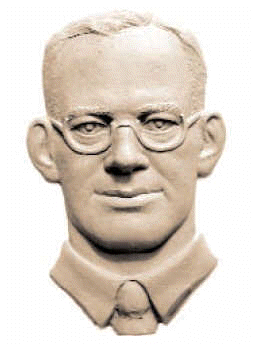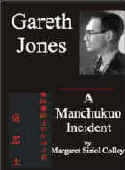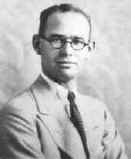Gareth Jones
[bas relief by Oleh Lesiuk]
HOME |
Stop Press |
Complete Soviet Articles & Background Information |
Précis of Gareth's
|
All Published Articles |
BOOKS
|
|
|
|
More Than Grain of Truth(2005) |
|
|
TOPICAL
'Are you Listening NYT?' U.N. Speech - Nov 2009 |
Gareth Recognised at Cambridge - Nov 2009 |
Reporter and the Genocide - Rome, March 2009 |
Order of Freedom Award -Nov 2008 |
Premiere of 'The Living' Documentary Kyiv - Nov 2008 |
Gareth Jones 'Famine' Diaries - Chicago 2008 |
Aberystwyth Memorial Plaque 2006 |
GENERAL
Scholarship Fund |
Site Map |
Links |
Legal Notices |
Sponsored Links |
Contact |
The Western Mail 18th October, 1933Craftsmen of Wales Tweed-makers in a Glen at TalybontMill Founded in 1809By GARETH JONESAlong the road leading from Aberystwyth to Talybont, Cardiganshire, was a long procession of sheep. Fleet-footed sheep-dogs silently marshalled them, drove them, held them, stopped them, did anything with them at the call of their masters - healthy, red-faced farmers’ boys from the mountains. Some of the fleece then being carried on those frightened backs would, I reflected, one day attract admiration as Welsh tweed, which, I think, is as good as any of the other vaunted tweeds. It was, therefore, with added interest that I saw a notice announcing the “Lerry Mills.” I walked past some old cottages, greeted an affectionate brown spaniel dog which took a fancy to me ad entered a clean, low-roofed room with attractive black rafters against the whitewashed ceiling and with a floor of large stone slabs. What a variety of Welsh tweeds was piled up in that long, low room! Here were tweeds of sombre hue which would have warmed the heart of the most dour of deacons, and others of flashy taste would make one of P. G. Wodehouse’s startling dandies shriek with delight. Some of the thick tweeds would provide sufficient covering for an Esquimaux, and there were light tweeds which could almost be worn with comfort at the Equator. There were tweeds of artistic green colour, of deep rich blue, of delicate red, and of bright scarlet. ALL FROM WELSH SHEEP.All kinds and conditions of tweeds were assembled there all from Welsh sheep, all made there in the wooded glen and all cared for with pride by dark-haired Miss Morgan. In this room where the tweeds await buyers there are little touches which show the presence of a woman’s hand. Near the window there is a jug full of mauve Michaelmas daisies. On the black mantelpieces are old-fashioned blue willow-pattern plates. The fireplace is stuffed with red heather. In comes a bright, dark-haired man, Mr. W. L. Morgan, the manager, who is there on behalf of Mr. Pickering, ,the owner. He is a little out of breath, for he has just been talking to the farmers at the sheep mart. He takes me around the room, shows me first the “cartheni,” or fine Welsh bed-covers, the Welsh flannel, the hand-knitted socks made by an old lady in Talybont, and the scarves. “Look out of the window,” he tells me. I look out and see yards upon yards of brown tweed stretched out on a rack in the field. NOT MASS PRODUCTIONMr. Morgan is proud of his work. “‘It is not mass production,” he says; “it is handwork, and we cling to that part, the handloom.” I accompany him to scattered workshops of the mill, where ten men are employed. First I enter a room packed with wool almost to the ceiling. “It is a craft of its own to sort the wool,” says Mr. Morgan. “You must learn to feel the quality of the fleece with your fingers and there is a kind of instinct in it. We send some of the long, strong fourth quality fleece, which is called ‘britch,’ to Bradford for carpet-making.” We see the machines, driven by water, which complete the miracle of making cloth from fleece, the devil, the carding and combing machines, and others. Dozens upon dozens of wheels whir round in the task of strengthening the thread. IN LOVELY SURROUNDINGS.Now we walk alongside the stream to the looms. A deep pool, good for salmon, lies by the building. Hundreds of oak trees dot the hillside, pines add a darker note to the surroundings, and ashes give a lighter shade. The paths around are brown with autumn leaves and some leaves float slowly on the pond. When I leave this place and enter the grey building housing the looms I see Mr. J. J. Richards hard at work providing power by pressing his foot up and down. Some of the looms there, however, are worked by water from the River Len, but, like all who depend on water, the craftsmen of Talybont have been bewailing the drought. I notice some red cloth, and Mr. Morgan tells me of an old belief: “Many believe that with oil on it this cloth is good for rheumatism. It is worn round the neck for, illnesses, but, of course, it must be red! THE MAIN BUILDING.We leave the looms and return to the main building, a little higher up the stream. There three things impress me. The first is a young farmer with his cart coming in with a load of wool “three bags full,” from a farm with the resounding name of “Carreg Cadwgan.” The second is a remarkable machine no longer used, which shows the ingenuity of mankind. It is called teasler, and instead of having little needles or wires to comb the wool, it has hundreds of tops of the hard and prickly teasle plant tightly fixed. ON TENTER-HOOKS.The third is a “tenter rack,” and when I see it I realise the meaning of the term “on tenter-hooks.” The rack is 32 yards long and has stretched upon it brown tweed, which is held up by sharp hooks called “tenter-hooks” until it is fully prepared for all trials at the bands of the tailor and the wearer. Mr. Morgan tells me that the mill was founded in 1809. 1809! When the forces were amassing which were to make South Wales a land of coal mines and ironworks, in the beginning of the industrial revolution! 1809! When the troops were drilling which were to send the power of Napoleon hurtling over the abyss to defeat and dishonour. 1809! When the philosophers and the poets in Germany were working out the thoughts which in 1933 were to drive Hitler to the Chancellorship of Germany and fill the streets of Berlin with Brownshirts! 1809! When religion was winning a victory over the soul of Wales! It is a consolation to think that there are in Wales mills which have lived through the cataclysms of this age and still produce Welsh tweed and flannel from those sheep which flock our mountain sides. |
GARETH JONES (1905 -35) |




